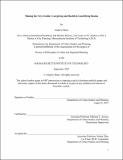| dc.description.abstract | How does the urban environment shape everyday caregiving practices? How does care mediate the relationship between cities and health? What are the planning ingredients of urban environments that support caregivers and viable caring relations? I answer these questions by analyzing data from interviews with caregivers conducted as part of the Healthy Neighborhoods Study, a longitudinal Participatory Action Research project exploring the relationship between gentrification and community health in nine Boston-area neighborhoods. First, I find that the strategies respondents employ to fulfill caregiving goals are shaped by the availability and adequacy of specific components of the urban environment, which I argue comprise the urban infrastructure of care. However, this infrastructure may be unavailable, inaccessible, inadequate, or poorly connected. Caregivers compensate for these shortcomings by securing, connecting and maintaining the components of the urban infrastructure of care to ensure satisfactory background conditions for caregiving. By shaping the extent and nature of this “infrastructural labor,” cities influence what forms of care are possible and what the work of care demands from caregivers. Second, comparing caregivers’ experiences at different stages of gentrification, I find significant differences in their perceptions of changes in local urban infrastructures of care, and in what the work of care entails. I argue that gentrification produces “care insecurity” for respondents: diminished confidence in the ability to provide satisfactory care in the future and to adapt to neighborhood changes that impact caregiving. Finally, I explore the hypothesis that changes in the urban infrastructure of care could produce caregiver stress, and that stress might thus be a pathway through which the relationship between caregiving and the urban environment becomes embodied by caregivers. I find that the challenges of performing infrastructural labor necessary to care can be physically, mentally and emotionally depleting for caregivers with negative consequences for their health and wellbeing. I conclude by proposing a framework for “planning for care” focused on the intertwined priorities of alleviating and equitably distributing the burden of care work, proliferating the possible forms that care can take, and maximizing people’s freedoms to give and receive care in ways that they value. | |
